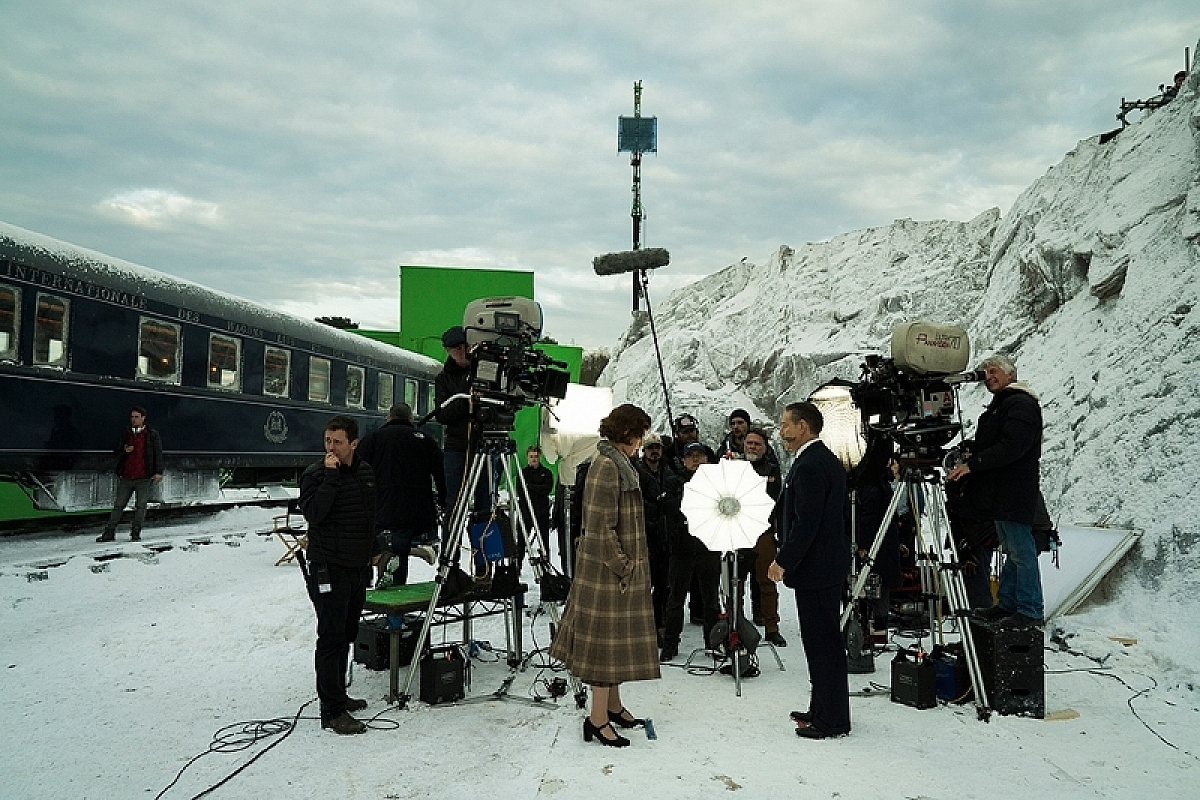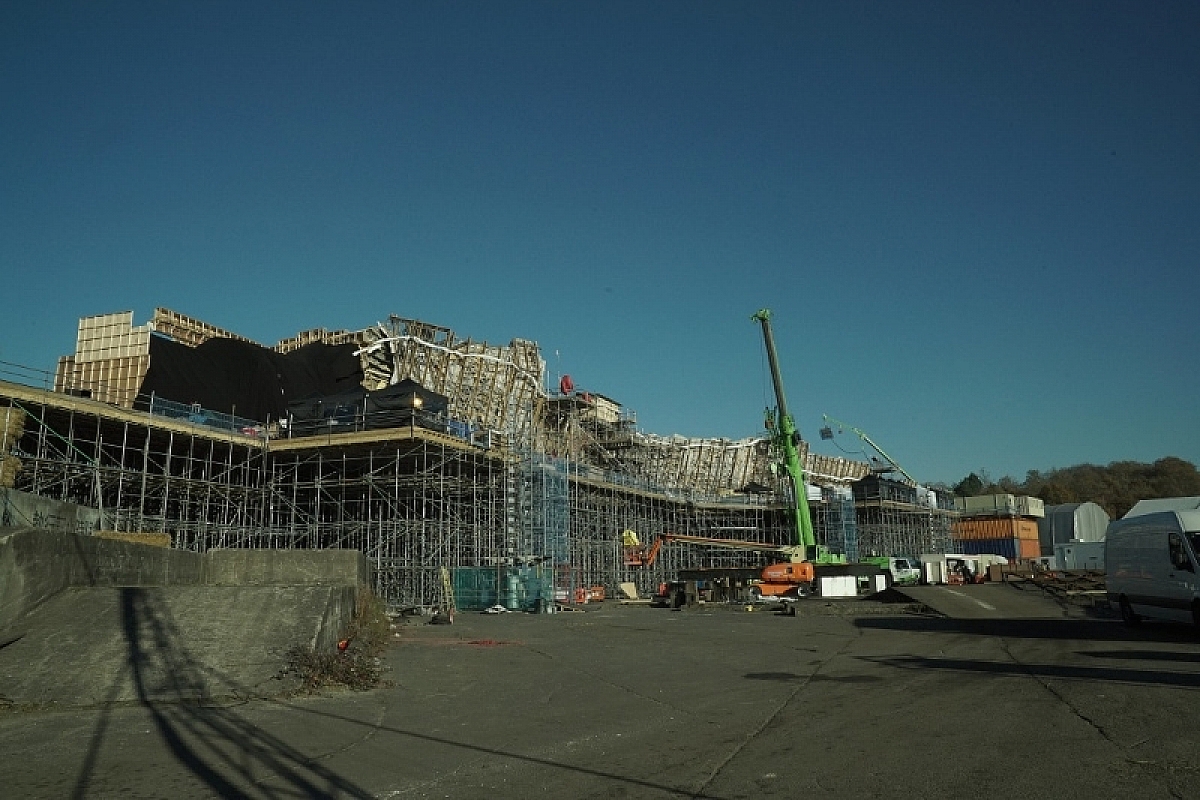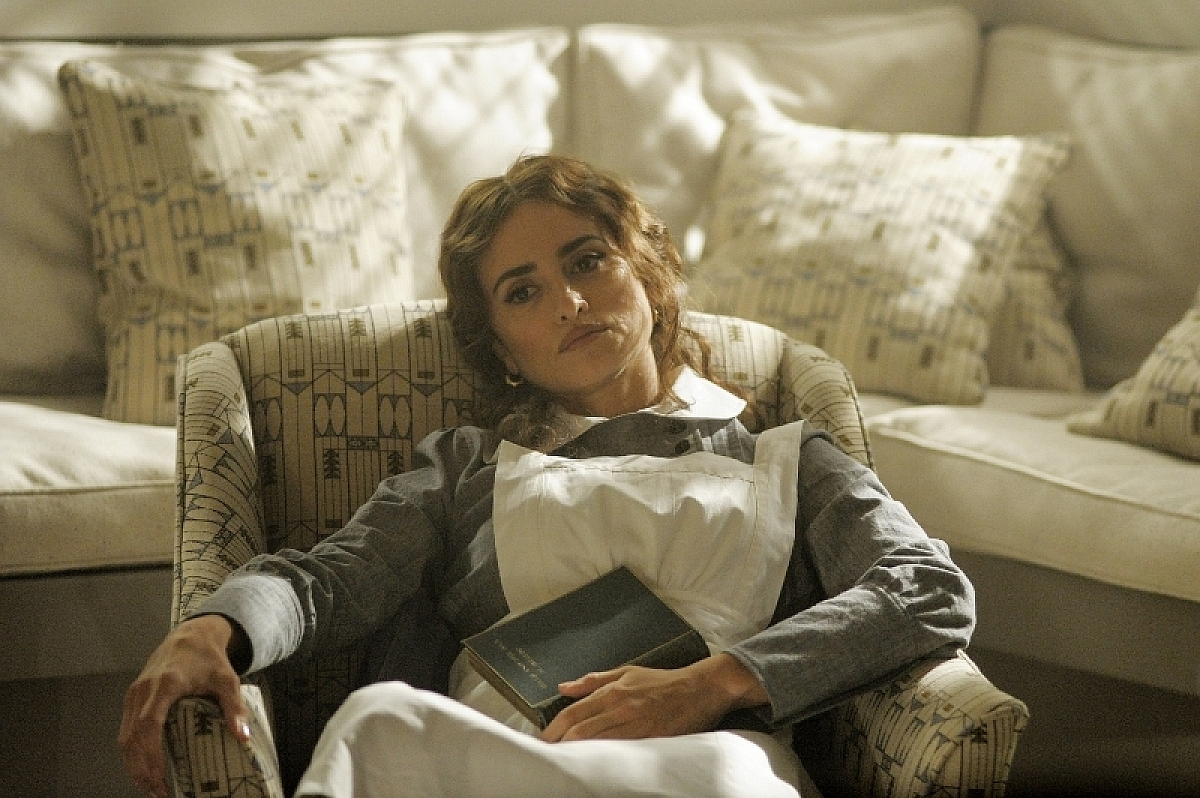Director Kenneth Branagh and DP Haris Zambarloukos BSC GSC used Kodak 65mm film for an intimate, emotional journey in 'Murder on the Orient Express'

Kenneth Branagh stars in and directs Twentieth Century "Murder on the Orient Express". Photo by Nicole Dove. © 2017 Twentieth Century Fox Film Corp. All Rights Reserved.
A sumptuous steam train journey through the wintery mountains of Eastern Europe comes to an abrupt halt after an avalanche stops its progress and a gruesome murder is discovered on-board. Thankfully, the famous Belgian detective, Hercule Poirot, is at hand to investigate.
Shot on large format Kodak 65mm film and based on Agatha Christie’s 1934 bestseller of the same name, Murder on the Orient Express, marks the fifth cinematic collaboration between director Sir Kenneth Branagh and cinematographer Haris Zambarloukos BSC GSC. Their previous successful outings together include Sleuth (2007), Thor (2011), Jack Ryan: Shadow Recruit (2014) and Cinderella(2015) – all captured on 35mm film.
20th Century Fox announced Murder on the Orient Express in December 2013 and confirmed Branagh as its star and director in November 2015. The film also features Penélope Cruz, Willem Dafoe, Judi Dench, Johnny Depp, Josh Gad, Derek Jacobi, Leslie Odom Jr., Michelle Pfeiffer, Daisy Ridley and Olivia Colman.

Getting ready for a take on "Murder on the Orient Express". Photo by Nicole Dove. © 2017 Twentieth Century Fox Film Corp. All Rights Reserved.
Several months before the live-action shoot went into full swing, Zambarloukos oversaw the capture of background plates shot in the New Zealand Alps that would be later used as the frosty backdrops. It was only after this footage had been stitched together, color graded and uploaded to an “enhanced LED environment” surrounding the locomotive and carriages that production on 65mm film began for real.

Daisy Ridley and Kenneth Branagh on the set of Twentieth Century Fox's "Murder on the Orient Express". Photo by Nicole Dove. © 2017 Twentieth Century Fox Film Corp. All Rights Reserved.
Principal photography involving the stellar cast began at the end of November 2016 at Longcross Studios, UK, where large and elaborate sets had been built. These included the movie’s Istanbul and Brod railway station scenes, as well as a specially-constructed railway viaduct where the steam train comes to a standstill due to the avalanche and where much of the investigative drama unfolds.

The viaduct set at Longcross Studios UK on Twentieth Century Fox's "Murder on the Orient Express". Photo by Nicole Dove. © 2017 Twentieth Century Fox Film Corp. All Rights Reserved.
Branagh is no stranger to large format film production. He previously directed and starred in Hamlet(1995), shot on 65mm film by DP Alex Thomson BSC; and recently performed in Christopher Nolan’s Dunkirk (2017), which was captured on Kodak 65mm filmstocks by DP Hoyte Van Hoytema FSF NSC.

Kenneth Branagh (r) and cinematographer Haris Zambarloukos on the set of Twentieth Century Fox's "Murder on the Orient Express". Photo by Nicole Dove. © 2017 Twentieth Century Fox Film Corp. All Rights Reserved.
“For me, filmmaking is all about suiting the format to the subject matter,” Branagh remarked. “After the Bible, the two best-selling authors on the planet are William Shakespeare and Agatha Christie. For this level of elite craftsmanship, an elite treatment on film was appropriate. With Hamlet, I wanted to demystify The Bard’s work and make the human dimension shine through using 65mm film. With Murder on the Orient Express, I wanted to get away from over formal, heritage theatre and to present the audience with a warts-and-all grittiness to the truth of the lives of the characters in this story – for us to smell the steam, to be immersed in the stylish splendor of the golden age of locomotive travel, whilst also looking into the eyes and exploring the interior vulnerabilities of these very different and complex characters. Film, and especially 65mm large format film, has that special intimacy and immediacy.”

Olivia Colman, left, and Judi Dench star in Twentieth Century Fox’s "Murder on the Orient Express. Photo by Nicole Dove. © 2017 Twentieth Century Photo by Nicole Dove. © 2017 Twentieth Century Fox Film Corp. All Rights Reserved.
Zambarloukos selected three 65mm film stocks for the production – KODAK VISION3 500T (5219) for night and interior work, along with KODAK VISION3 250D (5207) and 50D (5203) for the movie’s exterior scenes.
“Large format film captures the spectacle of landscapes wonderfully well, but you can also shoot portraits that let the eye roam and really absorb the character. It is so immersive that the frame just vanishes, and the intimacy is amazing,” said Zambarloukos. “Aesthetically, the Kodak stocks are all fine grain with lovely color rendition. On a practical basis, they are seamless, in that I could use them to cover the widest variety of lighting conditions and switch between them to optimize the length of our shooting day without seeing the join.

Michelle Pfeiffer stars in Twentieth Century Fox’s "Murder on the Orient Express". Photo by Nicole Dove. © 2017 Twentieth Century Fox Film Corp. All Rights Reserved.
“The 500T sees everything – nuances of color and details in the highlights and black areas. We had several low-light, noir-ish scenes, lit just by practicals, and the 500T captured these perfectly. As we were shooting in mid-winter in the UK, I used the 250D for most of the exterior scenes. It also sees into the shadows and allowed us to extend the shooting day to the very brink of the daylight.”
Zambarloukos also noted, “The 50D takes the 65mm film experience to another level. For example, we used it for an exterior scene on the viaduct between Poirot and Mary Debenham. The level and the nuances of the colors are extraordinary, especially in the mid-tone where the faces are, compared to what you might get digitally. The sheer definition is awesome. You feel you are really there with Poirot, imbibing the smallest glances and flickers of eyelids. This is 65mm film at its most immersive and intimate, and it’s far more dimensional than 3D.”

Kenneth Branagh and Daisy Ridley star in Twentieth Century Fox’s "Murder on the Orient Express". Photo by Nicole Dove. © 2017 Twentieth Century Fox Film Corp. All Rights Reserved.
While Branagh has starred in a variety of film and digitally-acquired cinema and television productions, when it comes to directing, celluloid remains a firm favorite. His 15 motion picture directorial credits, as well as a trio of shorts, have all been captured on film. His next production, Artemis Fowl, also being lensed by Zambarloukos, will shoot on celluloid too.

Kenneth Branagh (l) getting ready as Poirot, while cinematographer Haris Zambarloukos BSC GSC (r) discusses the next shot on "Murder on the Orient Express". Photo by Nicole Dove. © 2017 Twentieth Century Fox Film Corp. All Rights Reserved.
“I am always drawn to what film can offer,” Branagh said. “We deal in an ephemeral art form, and putting the muscle, the human dimension, into a production needs to be pursued wherever possible. There is a unique quality in film grain that creates the illusion of a greater sense of reality – there’s a different kind of visual engagement with human features and skin tones.”

Johnny Depp stars in Twentieth Century Fox’s "Murder on the Orient Express". Photo by Nicole Dove. © 2017 Twentieth Century Fox Film Corp. All Rights Reserved.
However, along with the aesthetic qualities of film, Branagh is also highly-attuned to other attributes of the celluloid capture medium and their overall effect at the cinema. As he explained, “When you use film, you get a deep understanding of imagemaking and storytelling. The sight and sound of film whirling through precise mechanical sprockets in the camera, the ritual and rhythm of loading/unloading, give you precious connections to the previous 100 years of cinema. These visual, audible and tactile qualities foster an interplay between the collaborators on set, that I believe the audience can intuit when they go to the cinema. They can sense a different level of commitment to the storytelling from the cast and crew, than you might otherwise have with a digital production.
“It’s hard not to underestimate the impact of Dunkirk, one of the most successful films of 2017, from a master filmmaker at the top of his game. It was a privilege to have been involved. It’s a very special cinematic event experience. Large format film invites you into the spectacle of a scene and the human emotions. With Chris’ film we have seen a wonderful example of what film can do at a time when people can be entertained in many other brilliant ways on small and large screens alike.

Penélope Cruz stars in Twentieth Century Fox’s "Murder on the Orient Express". Photo by Nicole Dove. © 2017 Twentieth Century Fox Film Corp. All Rights Reserved.
“I hope by shooting Murder on the Orient express on large format 65mm film, that we make a similarly positive and distinctive contribution too. There is still something truly special to celebrate about film. I am very glad Kodak is in a position to remain offering film to the service of filmmakers, as I believe the public are very interested in the results.”
Fittingly, Murder on the Orient Express was the opening screener at the 25th anniversary edition the Camerimage Festival of Cinematography where Branagh was bestowed with the prestigious Krzysztof Kieślowski Award, recognizing a performer’s contribution to the art of filmmaking, and the Cinematographer-Director Duo Award shared together with Zambarloukos.